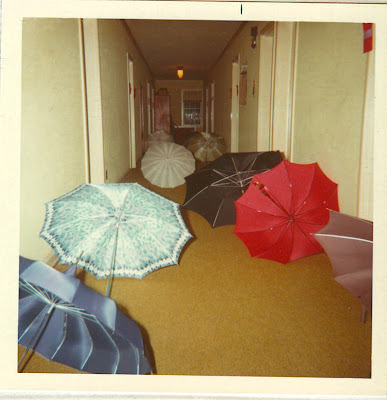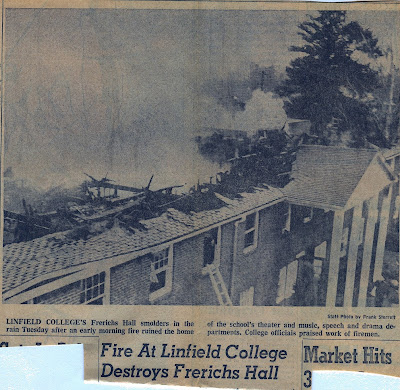Last Friday I had brunch with my college roommate Debbie and her husband Bob. We attended
Linfield College in McMinnville, Oregon. Deb and Bob were high school sweethearts and they were freshman during my sophomore year. Regrettably, finances prevented them from remaining at Linfield. I was fortunate to graduate from Linfield with a BA in English.
We, of course, talked and talked. Primarily about family and current topics. Not until we were parting did we take a brief trip down memory lane. This inspired me to dig out my college photo albums and revisit the journal that I began when I started college.
What a hoot! And what an eye-opener! I can't believe the significant historical events that occurred during the 1969-70 academic year.

Pioneer Hall
Pioneer Hall still stands, although the Old Oak at the far left in the photo is no longer with us. The bell tower is one of the college's symbolic images. At the time we attended, Pioneer was a multipurpose building that contained dorm rooms, classrooms and, if I recall correctly, the campus radio station.

Roomies: Mary and Debbie
I guess we were all too busy to snap many photos. This is the only one I have of the pair of us, and I have no photos at all of Bob. Sorry, Bob. The three of us did a lot together, including attending games, movies in town, trips to Portland, and hanging out in the dorm lounge.

Failing Hall
Not a reflection of our grades, but named after Jane Failing. It was the largest girls' dorm on campus. The two windows of our room are on the second floor just to the left of the white porch cover. We moved to a corner room at the rear of the dorm for second semester.

Second floor, Failing Hall
Winter in Oregon -- wet, wet, wet. I couldn't resist this characteristic photo of umbrellas drying outside our rooms.
* Resident dorm mothers (all white-haired) ruled dorm life.
* Dorms were unlocked until "closing," which was a mandatory curfew until we all got card keys.
* Male students were restricted to the lobby and main lounge of the girls dorms until inter-visitation was permitted. After buzzing the girl's room, she escorted him to her room with a warning announcement ("Man on the floor!") to prevent embarrassing encounters.
* Amy Tan was a freshman living down the hall from us. Yes, that Amy Tan.
* Refrigerators and microwaves in the rooms were decades away. Popcorn poppers did multiple duty to warm up canned soup, cook saimin, etc. The Hawaiian students all had rice cookers in addition.
* Dorm telephones were communal -- one to a floor.
* My books cost $29.03 for first semester, and $29.00 for second semester.
* Attendance at Chapel was still required at the Baptist-affiliated college.
* All research was conducted at the library. Our "search engines" were the card catalogue and book indices.
* All meals (except Sunday dinner) were served at The Commons (Dillin Hall).
* Riley Student Center was remodeled in bright reds and oranges to include a fireside lounge, terrace, study rooms, and snack bar.
* Movies showing at the McMinnville theater included: Last Summer, Butch Cassidy and the Sundance Kid, Midnight Cowboy, Alices' Restaurant.

* Frerichs Hall, the music, speech, and theater building was destroyed in a fire in December 1969. Frerichs and adjacent Graf Hall were repurposed army barracks that had been faced with brick to match the other buildings on campus. We were awakened by the sound of the fire fighters' loud speakers and looked out the window to see smoke and flames shooting into the sky. They next morning students dove into the wet, smoky remains to salvage what books, instruments, and other items that survived.
* Linfield's basketball team was hot. Scores broke 100 in successive games, and the Wildcats qualified for the national NAIA championships.
* The student senate approved smoking on campus, excluding classrooms.
* The college's first coed dorm was approved for the 1970-71 academic year. Male and female students would live on alternate floors.
Notable Historic Events:
* Draft approved for Viet Nam War and lottery numbers drawn. My recollection is a grim and tense gathering of guys and gals in the dorm lounge to watch the lottery results on TV.
* The Viet Nam Moratorium was held April 15, 1970. Students participated in anti-war marches and/or boycotted classes.
* Students protested Nixon's decision to send troops into Cambodia. Six students at Kent State were killed by National Guardsmen.
* The space program was still exciting. We camped out in the dorm lounge to watch the November 18, 1969 Apollo launch.
* Apollo 13 had problems before launch and the mission was aborted when the capsule experienced a power failure.
* The first Earth Day was celebrated on April 22, 1970.
Amazing stuff. I guess we knew we were living during interesting times during the 60s and 70s, but it takes a retrospective evaluation to realize just how interesting they were!









.jpg)











